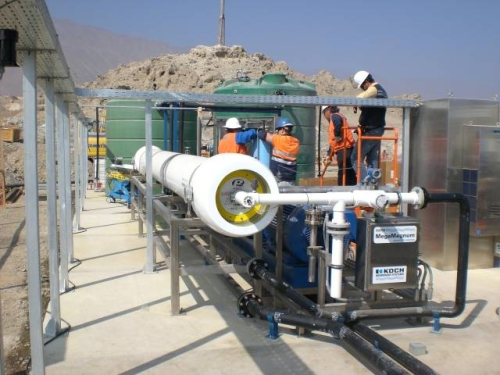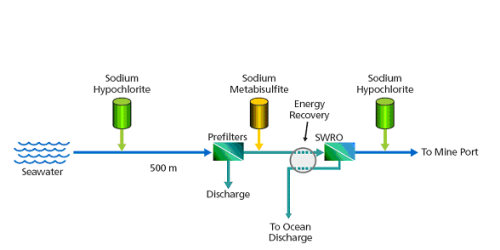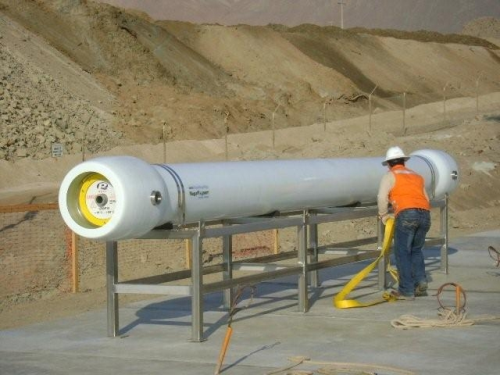


Workers at Chilean copper-gold mine port facilities will soon be quenching their thirst with drinking water from a new seawater reverse osmosis (RO) system supplied by Koch Membrane Systems (KMS). The system is the first full scale large diameter membrane RO system for seawater that KMS has developed. It uses Koch Membrane Systems’ MegaMagnum high capacity seawater membranes, made from a thin film composite developed specifically for seawater applications.
Located in the Antofagasta region of Chile’s north coast, Minera Esperanza’s copper-gold mine is about 1,500 kms north of Chile’s capital city of Santiago. The area is a desert, with extremely scarce supplies of drinking water. As a result, the Chilean government has placed constraints on drinking and industrial water supply, requiring developers of mines and other industrial facilities to provide their own water.
The initial RO facility will supply water to the mine’s port facilities at Michilla Port, which is located about 170 kms (105 miles) from the mine. The port is used to ship copper concentrate out of Chile. The overall water treatment facility, being developed by Nicolaides S.A., will provide drinking water to the mining camp as well as process water for the filter units which will concentrate copper coming down from the mine.
A second RO system is already in the next project phase. This will involve pumping seawater from the port through an insulated underground pipe to the mine at an elevation of more than 2,600 m (8,530 feet) above sea level. There, the seawater will be stored in a 50,000 m³ pond. Mining operations will take seawater from the storage pond and process it through a series of filters and finally an RO system. The desalinated water will be used for both processing operations and drinking water.
“The prevalence of gold and copper mines in the region, which require a lot of water with different salinity level requirements, made the seawater RO system one of the only feasible options for obtaining water for construction, drinking, mining operations and processing,” said Sergio Ribeiro, Koch Membrane System’s commercial director for South America.
He added, “By using the seawater RO systems, Minera Esperanza can provide a safe and plentiful water supply to its workers at the mine and to all the port facilities. KMS believes that MegaMagnum seawater RO systems show great potential for the future in this area. The large diameter MegaMagnum solution offers a number of features that make it ideal for the location and required capacities, including its small footprint, lower power consumption, high productivity and excellent permeate quality.”
Why choose MegaMagnum?
While other technologies were reviewed to meet the demands of the mining operation, a seawater membrane solution was the most feasible, because of the lack of available surface or ground water. The options then came down to an 8 inch version of seawater RO membrane, or large diameter MegaMagnum elements. Nicolaides chose MegaMagnum seawater elements to take advantage of the significantly reduced footprint, project costs and installation time. The large diameter RO systems use one-seventh the number of elements compared to standard 8 inch elements and also contain far fewer of the O-ring seals that prevent mixing between the seawater and product water. This results in significantly lower maintenance costs over the life of the plant.
KMS has made the loading and unloading of the larger MegaMagnum elements safe and easy with the use of a hand-operated winch. As a result, it typically takes less time to empty and load one pressure vessel containing MegaMagnum elements than the comparable number of 8 inch pressure vessels. The RO system was designed for years of reliable operation and can be easily maintained using on-site routine maintenance practices. The system includes an energy recovery device and was designed and built to minimize the life cycle costs over the system’s 20-year life expectancy.
Pilot at port is simple and effective
KMS initially installed a pilot unit at the port to demonstrate the effectiveness of the large diameter RO system and to provide water supply to the construction crew. Since it went on-line in the beginning of 2009, the facility has performed extremely well. KMS’ process engineers participated in the startup and the unit performed exactly according to its design specifications.
The seawater, drawn from about 500 m off shore in waters about 8 m deep, is pumped for approximately a mile to a water treatment unit which has a pre-filtration system provided by Amiad Filtration Systems Ltd. This pre-filtration contains a self-cleaning filter with a first stage of 25 microns, and a second stage of 3 microns. The system is designed to deliver water quality of less than 1 nephelometric turbidity units (NTU) and less than 3 silt density index (SDI).
From there, the water is pumped through the pilot RO system, which consists of a single vessel RO equipment skid with a total of 5 MegaMagnum seawater elements inside with a combined effective membrane surface area of 15,000 square feet (the equivalent of 38 standard size 8 inch x 40 inch elements).
The final permeate is then disinfected with chlorine, making it acceptable as drinking water and then the finished water is pumped to a storage tank in the port. The permeate capacity is 130,000 gallons per day given a maximum feed total dissolved solids (TDS) of 40,000 parts per million (ppm) and the required chloride concentration is less than 250 ppm in the finished water.
Permanent RO system at the port
The original pilot operates at a rate of 20 m³ per hour. Upon completion of the installation of the second phase of the project, this unit will be removed and will be replaced by the permanent RO system consisting of two new MegaMagnum MM2 units that will provide the port facilities with a capacity to store about 80 m³ per hour (520,000 gallons per day). Each MM2 unit is comprised of two seawater large diameter pressure vessels and the total project will utilize 20 seawater MegaMagnum elements.
The same pre-treatment and post treatment schemes that were used for the RO pilot unit will be used for the permanent RO system, including prefiltration using Amiad filters. The final permeate from the RO will be disinfected with chlorine.
Expertise and experience
Koch Membrane Systems’ experience with seawater RO systems is what drew Nicolaides’ attention when piecing together the right system for the harsh Chilean landscape. “We selected KMS to supply the seawater RO system due to the excellent job performed with the containerized RO skids,” said Fernando Mendoza, general manager for Nicolaides, SA.
RO helps solve water supply issue
The availability of reliable potable water is a key issue in developing mines and other facilities located far from developed regions. Since there is no potable water available at the mining site, and no other local water source available, the only other way to supply potable water would be to truck it from cities, the closest of which are from 50 to 70 kms away. Aside from the expense and reliability of such a system, logistical and transportation issues make it impractical to ship such a high total volume of water by truck.
“This mine is one of many that are using RO systems to get potable and industrial water for their operations,” said Henia Yacubowicz, Koch Membrane System’s director of process engineering. “In the future, we expect that most new developments will have to consider desalination as a water source, and we believe large diameter seawater RO systems show great potential for use in mining operations.”






